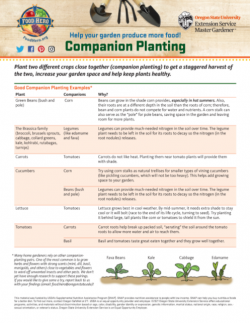Plant two different crops close together (companion planting) to get a staggered harvest of the two, increase your garden space and help keep plants healthy.
Good Companion Planting Examples*
| Plant | Companions | Why? |
| Green Beans (bush and pole) | Corn | Beans can grow in the shade corn provides, especially in hot summers. Also, their roots are at a different depth in the soil than the roots of corn; therefore, bean and corn plants do not compete for water and nutrients. A corn stalk can also serve as the “pole” for pole beans, saving space in the garden and leaving room for more plants. |
| The Brassica family (broccoli, brussels sprouts, cabbage, collard greens, kale, kohlrabi, rutabagas, turnips) | Legumes (like edamame and fava) | Legumes can provide much-needed nitrogen in the soil over time. The legume plant needs to be left in the soil for its roots to decay so the nitrogen (in the root nodules) releases. |
| Carrots | Tomatoes | Carrots do not like heat. Planting them near tomato plants will provide them with shade. |
| Cucumbers |
Corn
Beans (bush and pole) |
Try using corn stalks as natural trellises for smaller types of vining cucumbers (like pickling cucumbers, which will not be too heavy). This helps add growing space to your garden. Legumes can provide much-needed nitrogen in the soil over time. The legume plant needs to be left in the soil for its roots to decay so the nitrogen (in the root nodules) releases. |
| Lettuce | Tomatoes | Lettuce grows best in cool weather. By mid-summer, it needs extra shade to stay cool or it will bolt (race to the end of its life cycle, turning to seed). Try planting it behind large, tall plants like corn or tomatoes to shield it from the sun. |
| Tomatoes |
Carrots
Basil |
Carrot roots help break up packed soil, “aerating” the soil around the tomato roots to allow more water and air to reach them. Basil and tomatoes taste great eaten together and they grow well together. |
* Many home gardeners rely on other companion-planting pairs. One of the most common is to grow herbs and flowers with strong scents (mint, dill, basil, marigolds, and others) close to vegetables and flowers to ward off unwanted insects and other pests. We don’t yet have enough research to support these pairings. If you would like to give some a try, report back to us with your findings (email: food.hero@oregonstate.edu)!



